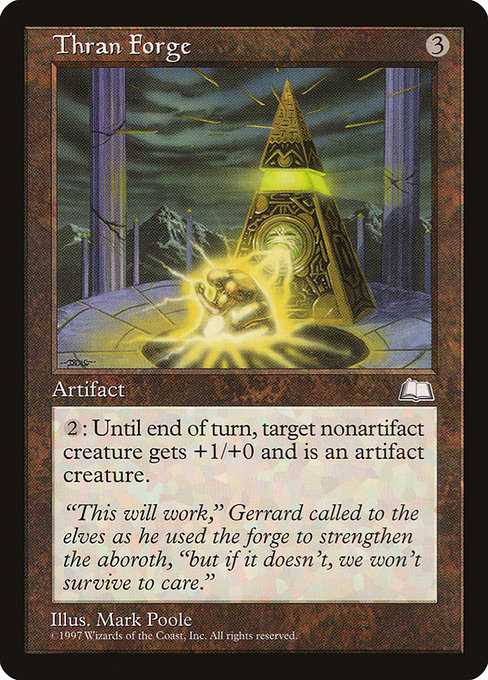
Image courtesy of Scryfall.com
Forge and Flavor: How Art Shapes Strategy in MTG
In Magic: The Gathering, a card’s art is more than a pretty picture; it’s a narrative cue that nudges players toward certain strategies, moods, and moments. Thran Forge, a Weatherlight-era artifact from 1997, is a quintessential example of how artwork and mechanics work in tandem to elevate gameplay flavor 🧙🔥. Created by Mark Poole, the illustration places Gerrard’s workshop in the foreground, a space filled with molten glow, rune-burnished metals, and the sense that ancient craft can bend the course of a battle. Even though the card’s text is concise, the image invites you to imagine the heat of the forge, the hiss of heated metal, and the momentary transformation of a creature into something newly forged and battle-ready ⚒️💎.
Art as a character in the story
The Weatherlight set is steeped in a lore-forward vibe, and Poole’s piece makes the forge feel like a living, breathing character in Gerrard’s crew. The warm amber and ember-red hues evoke a workshop where decisions are made in real time: will this be the spark that turns a fleeting opportunity into victory, or a misstep that leaves the party exposed? The artwork foregrounds a humble, temporary transformation—the creature becomes an artifact “in addition to its other types”—and that visual cue resonates with players who build around temporary buffs and strategic type-changes 🧭. The art doesn’t just illustrate the spell; it invites players to imagine the verb in action, to hear the clink of metal and feel the crackle of energy as power flows through a willing ally ⚔️.
This will work," Gerrard called to the elves as he used the forge to strengthen the aboroth, "but if it doesn't, we won't survive to care."
Mechanics that mirror the mood
Thran Forge costs three mana and grants a versatile, turn-by-turn effect: up to {2}, until end of turn, target nonartifact creature gets +1/+0 and becomes an artifact in addition to its other types. It’s a compact, spicy tempo play—you pump a threat and, just for a moment, unlock new possibilities by adding the artifact type. That tiny tilt—artifact typing, even temporarily—can unlock synergies with other cards that care about artifacts or artifact creatures, or simply enable an opponent to misread your board state by altering what your creature is capable of doing during that crucial swing. The art’s sense of forge-fire and rapid creation mirrors this tactical flavor: a moment of transformation that can shift the balance of a single combat or a broader plan 🧙🔥.
Flavor guiding deck-building intuition
Because the card is colorless and sits firmly in the artifact camp, it’s a natural fit for decks that lean on artifact synergy or that leverage Gerrard’s crew’s adventurous, improvisational mindset. It’s not a blanket pump; it’s a surgical, temporary upgrade that asks you to think about what your nonartifact creatures could become for one turn and why that matters. The decision becomes a narrative one as well: which ally benefits most from a short-lived artifact identity? Do you push for a surprise artifact-powered attack, or do you delay the transformation to bait a removal spell? The artwork nudges you toward the same question: what is this forge capable of forging under pressure, and who will wield that forged tool in the moment that decides the fight? 🎲
Set context and collectible heartbeat
Thran Forge hails from Weatherlight, a set that helped push MTG toward story-driven data and progressive flavor. Its rarity is uncommon, placing it among the thoughtful staples of the era—cards that players discover when they’re deeper into a draft or when they’re building around a particular arc of the Weatherlight narrative. The card’s lore text reinforces Gerrard’s hands-on approach to problem-solving: in a world where alliances shift like the tides, sometimes a simple forge-turn can be the difference between survival and ruin. The illustration by Mark Poole remains a touchstone for fans who remember the late 1990s’ art style—bold lines, dramatic light, and a sense of motion that makes the forge feel like a heartbeat in a cavernous workshop 🧡🎨.
As collector interest dips and rises with reprint cycles and the broader MTG market, Thran Forge remains a charming artifact of a pivotal era. Official price data shows a modest footprint, reflective of its uncommon status and the weathered charm of Weatherlight-era cards. For nostalgia-driven players and those who enjoy the tactile joy of a well-worn sleeve, it’s a card that marries lore with a practical, splashy play pattern—the kind of card you remember when you’re mid-game and the table’s energy shifts in an instant 🧭💎.
Artistry, design, and the sense of craft
Mark Poole’s work on Thran Forge captures a moment of craft and collaboration—the kind of team effort that defines Gerrard’s crew in Weatherlight. The art’s glow isn’t merely decorative; it’s narrative fuel. It tells you, without a single word, that this is a tool for making something new from something familiar. In a format where every card must justify a line of text, the image’s storytelling adds depth to the mechanic. The synergy between art and function is a reminder that MTG is as much about how a moment feels as about how it plays. For fans who love the union of lore, artwork, and strategy, Thran Forge stands as a small but mighty reminder: sometimes, forging a path is all about turning the ordinary into a story we remember long after the last card is drawn 🧙🔥⚔️.
Curious to carry a bit of MTG flair with you everywhere you go? If you’re shopping for gifts or a little fan-friendly gear, check out a sleek, protective accessory designed for on-the-go fandom. It’s a fun nod to the multiverse and a perfect companion for long flights, tournament runs, or weekend game nights with friends. The product link below offers a stylish way to show your love for the game while you’re out in the world. 🎲💎
Product spotlight